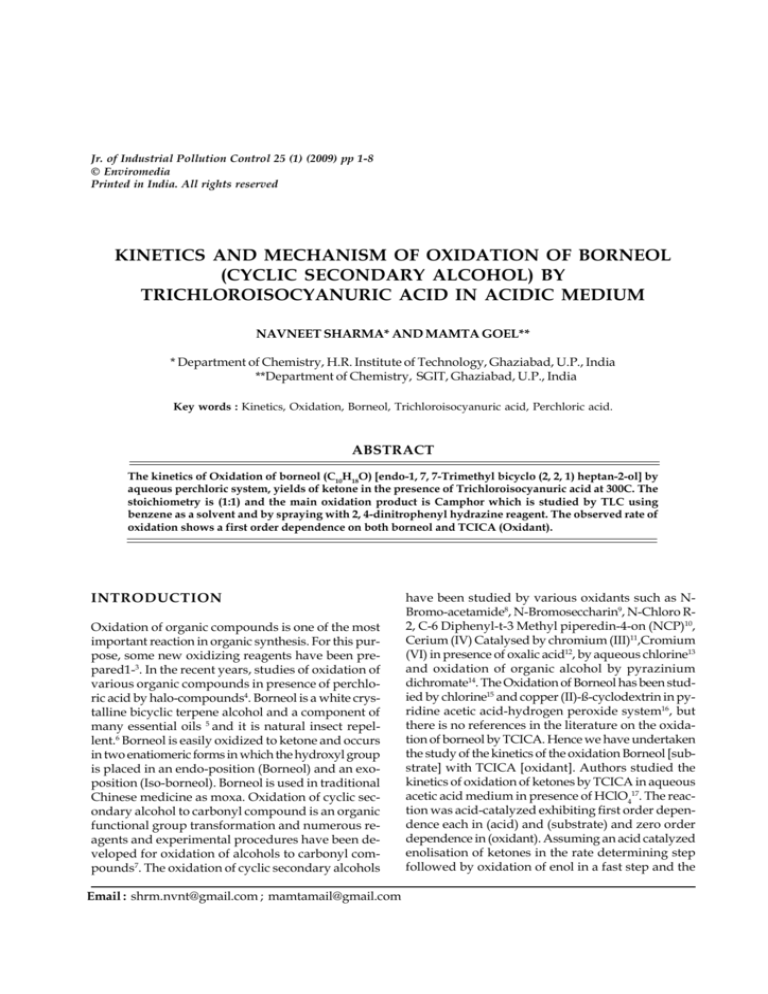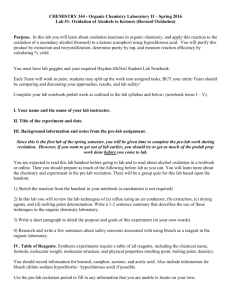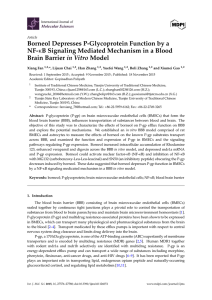
Jr. of Industrial Pollution Control 25 (1) (2009) pp 1-8
© Enviromedia
Printed in India. All rights reserved
KINETICS AND MECHANISM OF OXIDATION OF BORNEOL
(CYCLIC SECONDARY ALCOHOL) BY
TRICHLOROISOCYANURIC ACID IN ACIDIC MEDIUM
NAVNEET SHARMA* AND MAMTA GOEL**
* Department of Chemistry, H.R. Institute of Technology, Ghaziabad, U.P., India
**Department of Chemistry, SGIT, Ghaziabad, U.P., India
Key words : Kinetics, Oxidation, Borneol, Trichloroisocyanuric acid, Perchloric acid.
ABSTRACT
The kinetics of Oxidation of borneol (C10H18O) [endo-1, 7, 7-Trimethyl bicyclo (2, 2, 1) heptan-2-ol] by
aqueous perchloric system, yields of ketone in the presence of Trichloroisocyanuric acid at 300C. The
stoichiometry is (1:1) and the main oxidation product is Camphor which is studied by TLC using
benzene as a solvent and by spraying with 2, 4-dinitrophenyl hydrazine reagent. The observed rate of
oxidation shows a first order dependence on both borneol and TCICA (Oxidant).
INTRODUCTION
Oxidation of organic compounds is one of the most
important reaction in organic synthesis. For this purpose, some new oxidizing reagents have been prepared1-3. In the recent years, studies of oxidation of
various organic compounds in presence of perchloric acid by halo-compounds4. Borneol is a white crystalline bicyclic terpene alcohol and a component of
many essential oils 5 and it is natural insect repellent.6 Borneol is easily oxidized to ketone and occurs
in two enatiomeric forms in which the hydroxyl group
is placed in an endo-position (Borneol) and an exoposition (Iso-borneol). Borneol is used in traditional
Chinese medicine as moxa. Oxidation of cyclic secondary alcohol to carbonyl compound is an organic
functional group transformation and numerous reagents and experimental procedures have been developed for oxidation of alcohols to carbonyl compounds7. The oxidation of cyclic secondary alcohols
Email : shrm.nvnt@gmail.com ; mamtamail@gmail.com
have been studied by various oxidants such as NBromo-acetamide8, N-Bromoseccharin9, N-Chloro R2, C-6 Diphenyl-t-3 Methyl piperedin-4-on (NCP)10,
Cerium (IV) Catalysed by chromium (III)11,Cromium
(VI) in presence of oxalic acid12, by aqueous chlorine13
and oxidation of organic alcohol by pyrazinium
dichromate14. The Oxidation of Borneol has been studied by chlorine15 and copper (II)-ß-cyclodextrin in pyridine acetic acid-hydrogen peroxide system16, but
there is no references in the literature on the oxidation of borneol by TCICA. Hence we have undertaken
the study of the kinetics of the oxidation Borneol [substrate] with TCICA [oxidant]. Authors studied the
kinetics of oxidation of ketones by TCICA in aqueous
acetic acid medium in presence of HClO417. The reaction was acid-catalyzed exhibiting first order dependence each in (acid) and (substrate) and zero order
dependence in (oxidant). Assuming an acid catalyzed
enolisation of ketones in the rate determining step
followed by oxidation of enol in a fast step and the
Eco-1
2
SHARMA AND GOEL
following rate expression was given
- d [ CTICA ]
dt
= Ko [TCICA]o [Substrate] [H+]
Authors proposed that the nuclear chlorination
by Trichloroisocyanuric acid is the first order reaction each in [TCICA] and [substrate] & established
the following schemes.
TCICA + H2O k1 DCICA + HOCl
→
HOCl + H+
k2 H2O+Cl
→
H2O+Cl + Cl- k3 H2O + Cl2 ( In Presence of Cl-)
→
By far the most reliable factor for a kinetics study
is the effect of concentration. Variation of concentration of a reactant with fixed concentration of other
reactants, leads to the determination of order with
respect to that reactant, such a study provides information as to what function the rate is of the concentration of that reactant. A review on the functional
dependence of the various reactant on the rate, leads
to the rate expression 18.
Experimental
The cyclic secondary alcohol (substrate) i.e Borneol
(Lancaster) purified by recrystallisation from water
and purity was checked by its melting point (2080C)
before use. Trichloroisocyanuric (oxidant) was of
Merck made and KI was of AR grade. Other chemicals (reagents) were of spectroscopic grade. TCICA
concentration was estimated iodometrically in acid
medium in accordance with reaction.
C3O3N3(Cl)3 + 6I- + H+
(TCICA)
C3O3N3(H)3 + 3I2 + 3Cl-
3
>
(ICA)
NaClO4 & HClO4 used were of annular grade.
The solution of NaClO4 was prepared by direct
weighing while that of HClO4 was prepared by dilution and strength was checked by titrating with
NaOH using phenolphthalein as indicator. All the
experiments were conducted under pseudo first order conditions using more than ten times the concentration of borneol over the concentration of
Trichloroisocyanuric Acid [TCICA]. The reaction
mixture containing requisite amount of all the reactants i.e. perchloric acid, sodium perchlorate (which
is used to maintain the ionic strength of the medium).
Borneol and doubly distilled water except oxidant
(TCICA) were kept in a corning glass bottle coated on
the outside with black japan and wrapped with a
black cloth was used as reaction Vessel so as to eliminate the possibility of photochemical effect in the thermostatic water bath at constant temperature 303K.
Fresh solution of TCICA was also kept in the same
thermo state. After 30 minutes, the required amount
of TCICA was added to the reaction mixture. The
progress of the reaction is monitored by measuring
unconsumed TCICA iodometrically at regular interval of time and poured in the conical flask containing ice-cooled 10% KI solution. After keeping for 10
minutes for liberation of Iodine, the liberated iodine
was estimated against a standard solution of sodium
thiosulphate with a micro burette using starch solution as indicator. The volume of sodium thio-sulphate
corresponding to the iodine liberated by unreacted
TCICA was noted. The rate constants (kobs) in replicates were reproducible with in ± 5%.
Stoichiometric Investigations
Carried out under the conditions [TCICA] = 0.002
mol dm-3, [borneol] =0.001 mol dm-3, [HClO4] = 0.02
mole dm-3, solvent aqueous acetic acid (50%v/v) and
temperature 300C were largely not meaningful because of the appreciable decomposition of TCICA,
However, the product was identified as camphor by
thin layer chromatography using benzene as solvent
and by spraying with 2,4 dinitrophenyl-hydrazine
reagent.
RESULTS AND DICUSSION
The reaction is first order in [TCICA] as revealed by
the constancy of kobs values obtained with different
intial [TCICA] and by the linearity of the plot of log
[TCICA] vs time. The rate of reaction increases as increase in the [borneol] at fixed [TCICA]. A plot of log
kobs vs log [borneol] in linear with unit slop indicating first order dependence in [substrate] Fig. 1. The
specific rate increases with an increase in the concentration of by hydrogen ions. Ionic strength is investigated by varing [NaClO4] at constant [HClO4].
Increase in ionic strength of the medium has no significant effect on the specific rate. To determine the
temperature coefficient and thermodynamic parameters, the reaction was carried out at different temperature.
A plot of log kobs Vs 1/T (T is the temperature) is
Eco-1
3
KINETICS AND MECHANISM OF OXIDATION OF BORNEOL
linear. Hence the kinetics of the oxidation of borneol
by Trichloroisoyanuric acid obey the rate law of first
order; in which product camphor (ketone) is formed.
ACKNOWLEDGEMENT
Authors gratefully acknowledge the Chairman & Director General HRGI and Dr. S.C.Gupta(Director
SGIT) for providing the necessary supports.
REFERENCES
Fig. 1 Plot of bg kobs Vs. Borneol concentration
FiSheldon, R.A. and Kkochi, J.K. 1981. Metal-Catalyzed
Oxidation of Organic Compounds (Academic Press),
New York.
Hudlick, M. 1990. Oxidations in Organic Chemistry, (American Chemical Society, Washington DC).
Plants Containing borneol (Dr. Duk’s Phytochemical and
Ethnobotanical Databases)
Chemical Information sun. ars-grin.gov. Retrieved on
2008-03-02.
Fieser, L.F. and Fieser, M.L. 1967. Reagents for organic
synthesis.11 : 44-147.
Selvaraj, K., Venkateswaran , V. and Ramarajan, K. 1994.
International J. Chemical Kinetics. (26).
Nimbalkar, L.V. , Chavan, A.M. and Gokavi, G.S. 1998.
J. of Physical Organic Chemistry. II.









